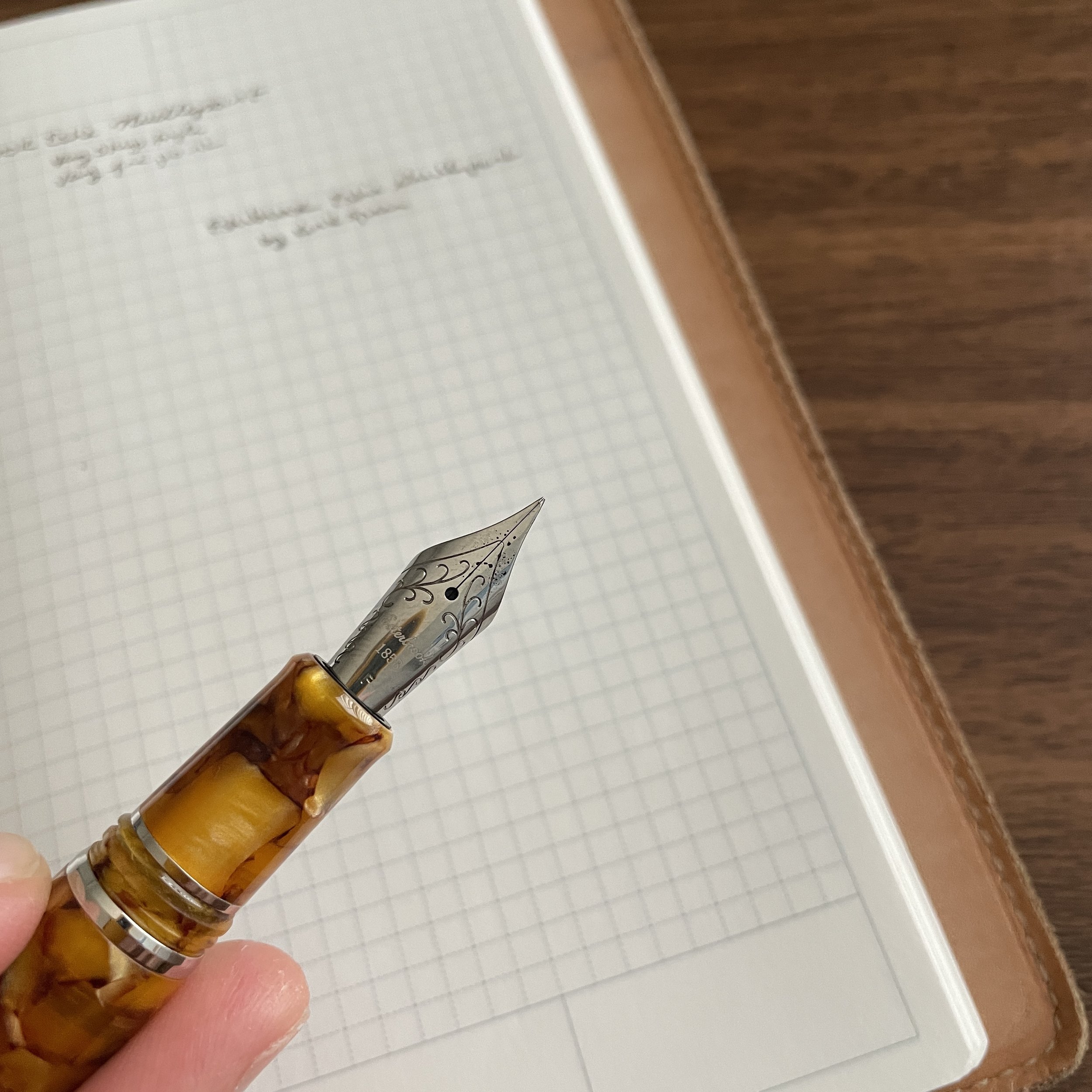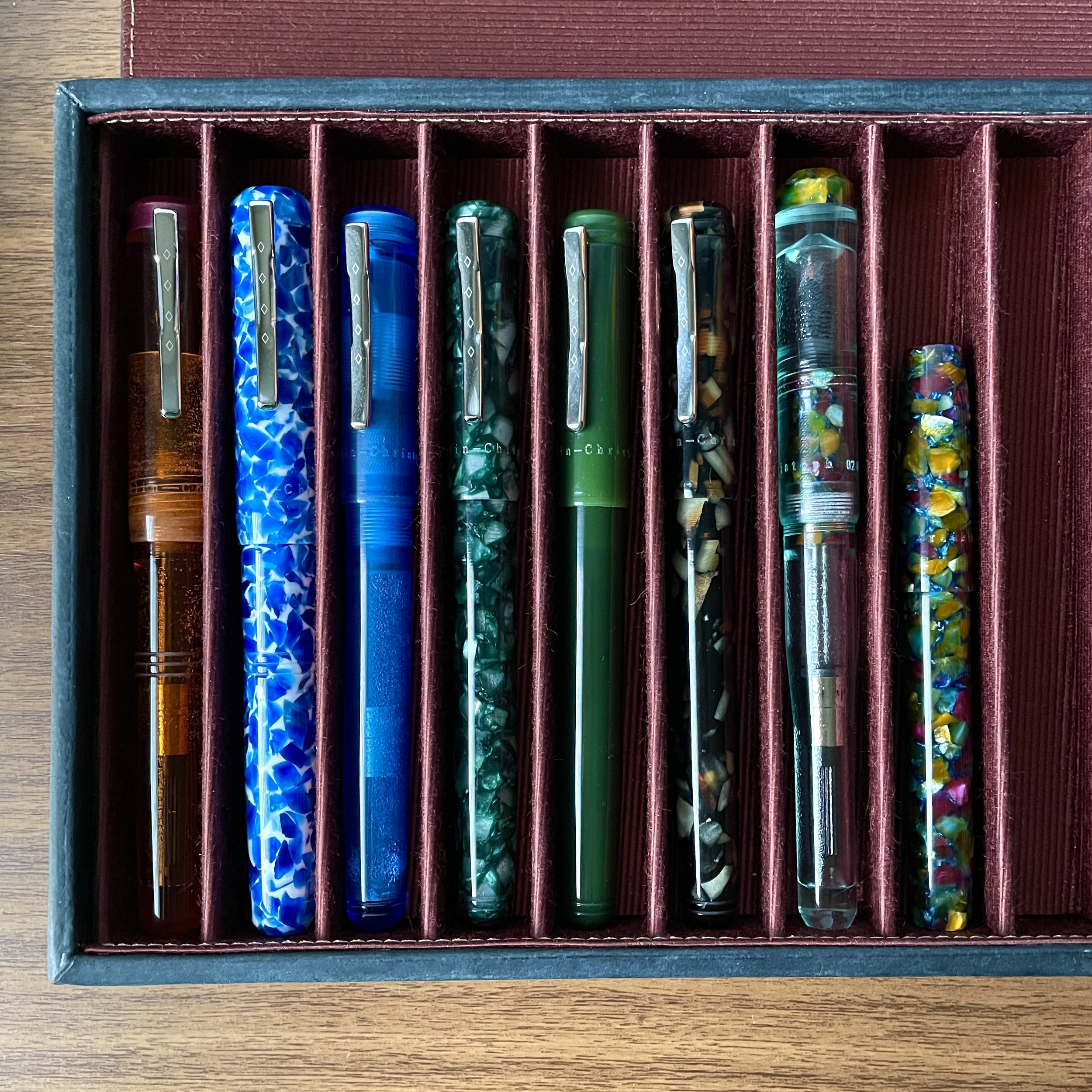Late last year I embarked on what I expect to be a year-long experiment of comparing custom nibs available from the different nib grinders currently working, focusing on those grinds from each that can be considered a specialty or “signature”. Mark Bacas is one of the most experienced nib grinders out there, and whether you’re looking for a simple tuning or a more complex grind like the “Predator Hybrid” I’m discussing today, Mark will work with you to ensure the nib is ground to your personal preferences, and that you’re happy with the result.
So What the Heck is a “Predator Hybrid” Nib?
I can only assume that the “Predator” name draws its inspiration from the shape - pictured at the top - which resembles a bird’s beak. The “Predator Hybrid” nib is ground to an ultra-fine point on the normal side, with the reverse a wider, slightly brush-like medium. To compare, a “Predator Extreme” nib has the same ultra-fine point on the normal side, with the reverse ground to a full architect. You can read Mark’s own descriptions on these and other nib grinds he offers directly on his site. I would say that on this “Hybrid” version, the reverse is slightly softer than a full architect, while still offering a bit of the line variation you would expect from that grind.
A writing sample showing the “normal” (i.e., nib down) width, compared against the reverse (i.e., nib upside down) width.
So in practice, how do I use this nib? If you’ve read my past pen reviews, you’ll know that I value pens I can use for annotation during my reading and research. This particular nib falls squarely into that category. The ultra-fine point accommodates my tiny handwriting and allows me to make even the smallest margin notes, while the reverse side is perfect for underlining, highlighting, and even standard writing. Frankly, I’ve never had a reversible nib write well to the point where I could use the reverse side for much more than a line or two. This one is smooth enough for standard writing.
The TWSBI Diamond 580 Fountain Pen is one of many that features interchangeable nib units, so you can have multiple custom nibs ground to switch among your various TWSBI Pens.
Why I Love Interchangeable Nib Units for Custom Nib Work
For this grind, I chose to have Mark modify a TWSBI 580 medium nib unit, so that I can swap the nib between my various TWSBI Diamond 580 pens. Lately, wherever possible I’ve been having nib grinders modify interchangeable nib units from JoWo, Bock, and TWSBI so that their work isn’t tied to any particular pen. It’s quite helpful to be able to move the nibs around at times - some grinds are more suitable to different pens, depending on weight, balance, etc., and these threaded nib housings make swapping nibs a cinch.
Cost of Nib Modification - Cheaper Than Buying a New Pen
The grind featured here cost $50, and since I did not pay a rush fee, it took several weeks for Mark to turn around. (Mark is fast - some nib grinders take months, or even up to a year.) In response to posts like these, I often get the question: “Why pay extra money to ‘fix’ a pen that should write perfectly out of the box?” Here I think we need to break down the question a bit: Are you paying to fix a manufacturer’s flaw with the nib, in which case I absolutely agree with you that the cost of any repair should be born by the company that made the pen, or are you looking to personalize the pen for how you write? It should be fairly obvious that if you write extremely small, a standard stainless steel extra-fine nib may not be narrow enough for you, and you should consider a needlepoint or a nib like the Predator.
The “normal” point of the Predator nibs writes a very fine line, even finer than a needlepoint nib like the one ground by Kirk Speer (Pen Realm) for Esterbrook.
Even with standard nib widths, it’s impossible for a manufacturer to anticipate things like the amount of pressure you use and how you hold the pen. I have pens in my collection that, out of the box, wrote within “the range of reasonableness” and wouldn’t be considered defective, but still didn’t work for me until I had them tuned. I would estimate that 80-85% of the pens in my collection have been modified or tuned from “factory standard,” either by a nib grinder or yours truly. At the end of the day, if you love the look of a pen, and it’s not writing perfectly, consider paying a little extra to make it yours. If you keep it for years, you’ll get more enjoyment from the writing experience than the $20-50 modification fee, and in many cases it’s cheaper than buying a new pen.
Further Reading
If you enjoyed this article, you may want to check out some previous posts discussing fountain pen nib modifications. I’ve written a general introductory piece on some of the more common grinds, as well as an article looking at custom grinds from The Nib Tailor (Architect + Inverted Architect), as well as the Kirk Speer Needlepoint nib currently available from Esterbrook as an add-on to Estie purchases.
This post does not contain third-party affiliate links. The Gentleman Stationer is supported entirely by purchases from the T.G.S. Curated Shop, as well as pledges via the T.G.S. Patreon Program. Since it’s Memorial Day Weekend, all orders placed in the Curated Shop from Saturday, May 28 through Monday, May 30, will receive a complimentary add-on gift! Many thanks for all of your support!



